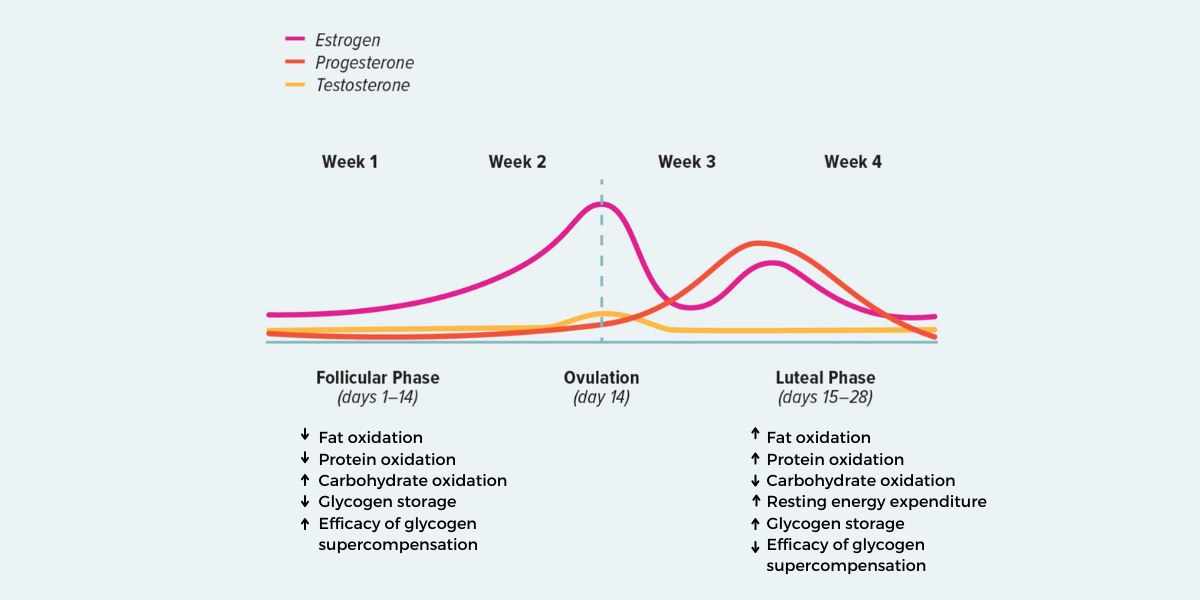Empowering Performance: Nutrition Strategies for the Female Athlete
Mar 08, 2024
Female representation in sport has increased in the last few decades. For example, 49% of the athletes participating in the 2021 Olympic Games were female compared to only 2% of participants in the 1900 Olympic Games or 13% in 1964. However, even though we've seen this improvement at the elite level, female athletes continue to be misrepresented in many areas of sport, including sports, exercise and nutrition research.
So far, most sports nutrition research and subsequent nutrition guidelines have been based on studies with primarily male participants. It was not until the last 5 to 10 years that we saw increased interest and demand for research on female athletes.
Women's hormonal cycles mean that estrogen and progesterone fluctuations affect metabolism and fluid retention differently. Here I summarise the top female-specific nutrition considerations for endurance athletes highlighted across the limited research available.
Energy
Consuming enough calories needs to be the female athlete's #1 nutrition priority. Not consuming enough energy to meet the body's metabolic and activity demands can disrupt menstruation, decrease performance, cause loss of bone mass and increase the risk for injury and osteoporosis. Unfortunately, previous data evaluating the dietary intake of female athletes reported that most athletes didn't consume enough calories.
Making specific adjustments based on the menstrual cycle becomes irrelevant without adequate energy intake.
Carbohydrate
Carbohydrates are considered vital during endurance activities, especially those of moderate to high intensity. Therefore, strategic consumption of carbohydrates around physical activity is beneficial for ensuring their availability.
Pre-exercise carbohydrate intake
Pre-training carbohydrate intake is more critical during the follicular phase when carbohydrate oxidation increases and glycogen reserves are reduced.
Female athletes can also benefit from a carbohydrate-loading nutrition protocol ahead of their most important races. This is because the capacity to "load" muscle glycogen is not sex-dependent as long as enough carbohydrate is consumed (8-12 g of carbohydrate per kg of body weight).
Carbohydrate during exercise
Consumption of carbohydrates during prolonged exercise is beneficial regardless of the menstrual cycle phase. However, female athletes appear to have a lower capacity to oxidise carbohydrates compared to males. With guidelines suggesting an intake of 30 to 90 g of carbohydrates per hour during prolonged endurance activity, it may be beneficial to consider a quantity at the lower end of the bracket and adjust according to tolerance and ability to sustain the effort.
Post-exercise carbohydrate
It is essential to consume carbohydrates immediately after prolonged exercise to restore the muscle glycogen used during the activity. Post-training carbohydrate ingestion can be more critical during the follicular phase since glycogen storage may be reduced. An intake of 1.2 g of carbohydrate per kg of body weight per hour in the first 1-4 hours after training is recommended.
Fat
Overall, females seem to rely more on fat oxidation as a source of energy than men. Additionally, fat oxidation appears to be higher during the luteal phase. Therefore, adequate fat intake (at least 20% of total energy intake) is necessary to meet the demands of sex hormone regulation, absorption of fat-soluble vitamins and the increased reliance on fat oxidation.
Protein
Recent research into active female protein requirements suggests that protein intake should be at least 1.6 g/kg of body weight per day during the follicular phase. This requirement may be higher during the luteal phase due to increased muscle protein breakdown rates.
Consuming 4 to 5 meals spread throughout the day with a total of 0.3 g of protein per kg body weight is recommended to maximise muscle protein synthesis.
Consuming protein after training is essential to support muscle protein repair and remodelling. Therefore, female athletes should aim to consume a source of high-quality protein as soon as possible as part of their post-training recovery meal.
Micronutrients
Deficiencies in iron, vitamin D and calcium are common in female athletes.
Iron
Female athletes at higher risk of iron deficiency include those following vegan or vegetarian diets, those with high amounts of repetitive ground strikes (e.g. runners), and those with heavy menstrual bleeding.
Calcium and vitamin D
Vitamin D is essential for immunity and injury prevention and works closely with calcium to promote bone health. Calcium is also vital to muscle contraction and relaxation.
Hydration
During the luteal phase, under the influence of high progesterone levels, body temperature can increase by 0.5–1.0 °C. Despite this increase, current evidence does not suggest an increased risk for heat illness (often secondary to dehydration) in women compared to men.
Female athletes should aim to start the activity in a hydrated state. In the case of hydration during exercise consuming 0.4 to 0.8 L per hour is sufficient for most athletes. However, understanding the athlete's sweat rate makes it easier to plan a more personalised hydration strategy.
Final remarks
More research exploring the specific effects of women's physiology on nutrition and hydration needs is still necessary to produce robust sports nutrition recommendations for female athletes. Fortunately, recent years have seen more female researchers and athletes advocating and working on this change... watch this space!
References:
- Holtzman, Bryan, and Kathryn E. Ackerman. "Recommendations and nutritional considerations for female athletes: health and performance." Sports Medicine 51.1 (2021): 43-57.
- Moore, Daniel R., Jennifer Sygo, and James P. Morton. "Fuelling the female athlete: Carbohydrate and protein recommendations." European Journal of Sport Science 22.5 (2022): 684-696.
- Rodriguez-Giustiniani, Paola, Nidia Rodriguez-Sanchez, and Stuart DR Galloway. "Fluid and electrolyte balance considerations for female athletes." European Journal of Sport Science 22.5 (2022): 697-708.
- Wohlgemuth, Kealey J., et al. "Sex differences and considerations for female specific nutritional strategies: a narrative review." Journal of the International Society of Sports Nutrition 18.1 (2021): 27.
Join the Fuelling with Purpose Newsletter!
Subscribe to my weekly newsletter and receive endurance nutrition tips, product recommendations, and energy-packed recipes delivered straight to your inbox.
We respect your privacy. Unsubscribe at anytime.


